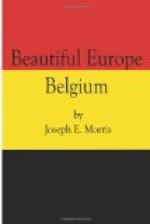Furnes—in Flemish Veurne—is an excellent centre from which to explore the extreme west point of Belgian Flanders, which is also the extreme west point of Belgium as a whole. Flanders, be it always remembered, does not terminate with mere, present-day, political divisions, but spreads with unbroken character to the very gateways of Calais and Lille. Hazebrouck, for example, is a thoroughly Flemish town, though nearly ten miles, in a beeline, inside the French border—Flemish not merely, like Dunkirk, in the architecture of its great brick church, but also actually Flemish in language, and in the names that one reads above its shop doors. In particular, excursions may be pleasantly made from Furnes— whose principal inn, the Noble Rose, is again a quaint relic of the sixteenth century—to the two delightful little market-towns of Dixmude and Nieuport-Ville: I write, as always, of what was recently, and of what I have seen myself; to-day they are probably heaps of smoking ruin, and sanguinary altars to German “kultur.” Nieuport-Ville, so called in distinction from its dull little watering-place understudy, Nieuport-les-Bains, which lies a couple of miles to the west of it, among the sand-dunes by the mouth of the Yser, and is hardly worth a visit unless you want to bathe— Nieuport-Ville, in addition to its old yellow-brick Halles, or Cloth Hall, and its early Tour des Templiers, is remarkable for its possession of a fascinating church, the recent restoration of which has been altogether conservative and admirable. Standing here, in this rich and picturesque interior, you realize strongly the gulf in this direction between Belgium and France, in which latter country, in these days of ecclesiastical poverty, loving restoration of the kind here seen is rare, and whose often neglected village churches seldom, or never, exhibit that wealth of marble rood-screen and sculptured woodwork—of beaten brass and hammered iron—that distinguishes Belgian church interiors from perhaps all others on earth. The church has also some highly important brasses, another detail, common of course in most counties of England, that is now never, or hardly ever, found in France. Chief, perhaps, among these is the curious, circular brass —I hope it has escaped—with figures of husband, wife, and children, on a magnificently worked background, that is now suspended on the northwest pier of the central crossing. Very Belgian, too, in character is the rood-beam, with its three figures of Our Lord in Crucifixion, of the Virgin, and of St. John; and the striking Renaissance rood-screen in black and white marble, though not as fine as some that are found in other churches. Rood-screens of this exact sort are almost limited to Belgium, though there is one, now misplaced in the west end of the nave, and serving as an organ-loft, in the church of St. Gery at Cambrai—another curious link between French and Belgian Flanders. Dixmude (in Flemish Diksmuide), nine and a half miles




